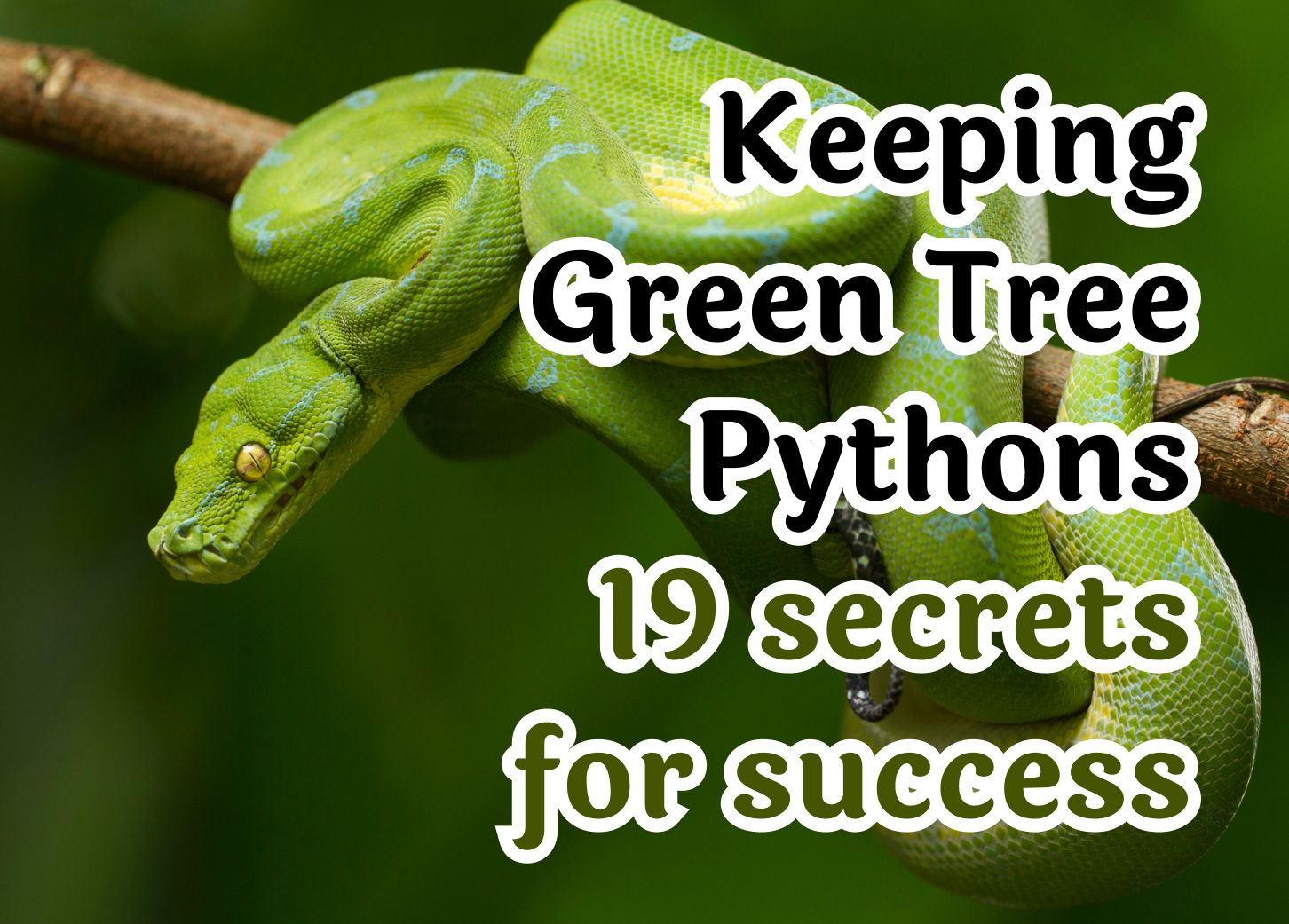19 Tips for Successfully Keeping Green Tree Pythons

Is taking care of a Green Tree Python difficult? Here’s everything you need to know about these gorgeous snakes.
Green Tree Pythons are mid-sized and stunningly beautiful rainforest boa snakes. This makes them the favorite choice of many reptile pet owners and it may make them the perfect pet for you too.
While Green Tree Pythons are not the most difficult snake to look after, however, they are not the simplest ones either. There are also quite a few specifics you’ll need to keep in mind to successfully and safely take care of such a snake. If you haven’t owned a snake before, don’t worry – this python is suitable for first-time snake owners as long as you follow the 19 points we’ll list below.
What are the key characteristics that make Green Tree Pythons special?
The first section of key points we’ll mention cover the specifics of the Green Tree Python. Afterward, we’ll go over the inventory you’ll need to look after these snakes:
-
Green Tree Pythons are nocturnal. This means that they seldomly move during the daytime and need to be fed and handled at night. A properly domesticated python can be handled in the day as well but it’s recommended to leave them be after the morning and until dusk.
-
These boas are arboreal. This means that they love to climb and cling to branches. We’ll cover the terrarium specifics below.
-
Green Tree Pythons are small-to-mid-size and can get as long as 5 or 6 feet max. They are pretty slender too and can appear even smaller when they have coiled around a tree branch.
-
These snakes can come in many color and pattern variations and are not just fully green. There are many blueish and yellowish color patterns and sections you can see in a Green Tree Python as well.
-
Always buy/adopt captive-bred snakes only. Like all other reptiles, wild-caught snakes can be more aggressive, less susceptive to tap and hook training, and more dangerous overall. Contrary, captive-bred snakes are used to being around humans, being handled, and living in terrariums.
-
Proper socialization and training are essential. Whatever python you’ve got, it’s crucial for both the snake and yourself that you go through the necessary training. Tap and hook training is a must if you want to safely feed and handle your snake, for example – here’ san instructional video by Dbcb Exotics.
As for good snake socialization, this is a good example by Blue Line Morphs. -
There are different sub-types of Green Tree Pythons. As these snakes come from not just New Guinea but also various islands around the mainland as well as the Cape York Peninsula of Australia and other islands, there are different sub-types of this boa.
This is important as there are both color differences between them and varying personality traits. For example, Biak Green Tree Pythons are known to be more easily irritable. -
Green Tree Pythons don’t hibernate. As a rainforest type of snake, these snakes aren’t used to experiencing tough winters that necessitate hibernation. That being said, you can expect to see a slight decline in their feeding behavior and overall physical activity during the winter months as the snake will feel the atmospheric changes around and in its terrarium.
-
Make shedding as easy as possible. Green Tree Pythons shed regularly like all other snakes. This is especially frequent in their early days. Shedding is a complicated and vital process that requires a well-maintained environment to be successful. You can sometimes notice the snake having issues with its shedding, especially around the head and the eyes.
This does NOT mean that you should physically assist with the shedding, however – never try to peel the skin off the snake by yourself. Instead, it’s important to make the process as easy as possible by maintaining a good relative humidity in the terrarium.
You should also add the right interior items such as a large water bowl and decorative items as the snake will use those to further assist its shedding. We’ll cover such items below.
What do you need to prepare before getting a Green Tree Python?
In addition to learning a bit more about the Green Tree Python, you’ll also need to acquire some special items and tools to best take care of your new boa:
-
Get a good tank/terrarium. Naturally, one thing you definitely need for this boa is a large terrarium. Adult Green Tree Pythons can grow to as much as 4 to 6 feet in length so you will need a large tank.
While younger snakes can be housed in 20-30-gallon tanks, for the time being, an adult needs at least a 36” by 18” by 36" tank – ideally even bigger. If you want your boa to be as happy as possible, make sure the tank is twice as long as the snake, and about as wide and as tall as her.
Glass and wood are usually the best materials for a reptile as a mesh won’t retain its humidity. Glass usually comes on top for most owners as it’s transparent. Also, make sure that the tank is opened from the front and not (just) from above – these snakes don’t like being approached from above. -
Use at least two thermometers. Like most other reptiles, Green Tree Pythons need very careful temperature management. This means not one but at least two thermometers per terrarium – one for the warm part of the tank and one for the cool part.
As for the exact temperatures you should be aiming at – Green Tree Pythons need a constant temperature of 82-84oF ( 28-29oC) with one basking spot that reaches 90oF (32oC). In the “cool corner” of the tank and especially at night, the temperature should be lower but not lower than 74oF (23.3oC). -
You’ll need a basking heat lamp. To achieve the aforementioned 90oF (32oC) you are going to need a basking heat lamp. Alternatively and/or for after-dark heating, you can use a ceramic heater.
-
Get a hygrometer too. Pythons also need a fairly precise humidity management so a hygrometer is necessary to help you make sure the terrarium has the right humidity levels. The relative humidity in the enclosure should never drop below 40% and can go as high as 70%. It can go above 70% for short periods after misting but not for too long or too often.
-
The tank will need a misting system. A good way to maintain a high humidity in the snake’s terrarium is to install a misting or fogging system in the tank. These can be set to mist at certain times and, together with the hygrometer, can help you ensure a perfect environment for your python at all times.
-
Make a good humidity box. For the occasions when your boa wants a bit higher humidity, giving her access to a humidity box is a good idea. That way, the snake won’t have to wait for a misting and can find the right environment for her needs at any moment. Check out this instructional video from Jessica’s Animal Friends on how to make a humidity box – just make sure it’s the right size for your snake.
-
Pick the right substrate. Fortunately, Green Tree Pythons can do well with many different types of substrates. Even something as simple as newspapers can work but if you want something more adequate you can go with aspen, dampened mulch, or the many types of other mulches and coconut husk substrates on the market.
-
Don’t skip the decorative items. Green Tree Pythons are arboreal snakes so you will have to put quite a few extra stuff in their terrariums to make them comfortable. Tree branches, rocks, even artificial climbing structures can all work well. Just make sure to secure the top of the terrarium as these boas are quite decent escape artists too.
-
The water bowl is crucial. Snakes “drink” water by soaking their entire bodies in the water bowl so make sure you get a big enough bowl for your Green Tree Python. Also, remember to change the water every day as snakes do have the habit of leaving their excrements in the water.
-
Get high-quality food for your snake. Green Tree Pythons prefer diets consisting of mice and chicks. The exact size of the prey should be no larger than the girth of the snake at its thickest (not counting the snake’s head).
If the portion is the right size, a baby python will typically need to eat once every 4-5 days and an adult snake – once every 10 days. If the prey is smaller than necessary, feed the snake once a week. As for the condition of the prey, our recommendation is that it’s pre-killed, kept in cold storage, and then thawed before consumption.
We understand the desire to feed your snake live prey but that’s ill-advised for numerous reasons but most importantly because:
-
You’ll risk the snake getting injured
-
You’ll stimulate the snake’s hunting instinct and desire for warm flesh food, making it more likely to attack you
-
Keeping the snake’s food in cold storage is much easier



